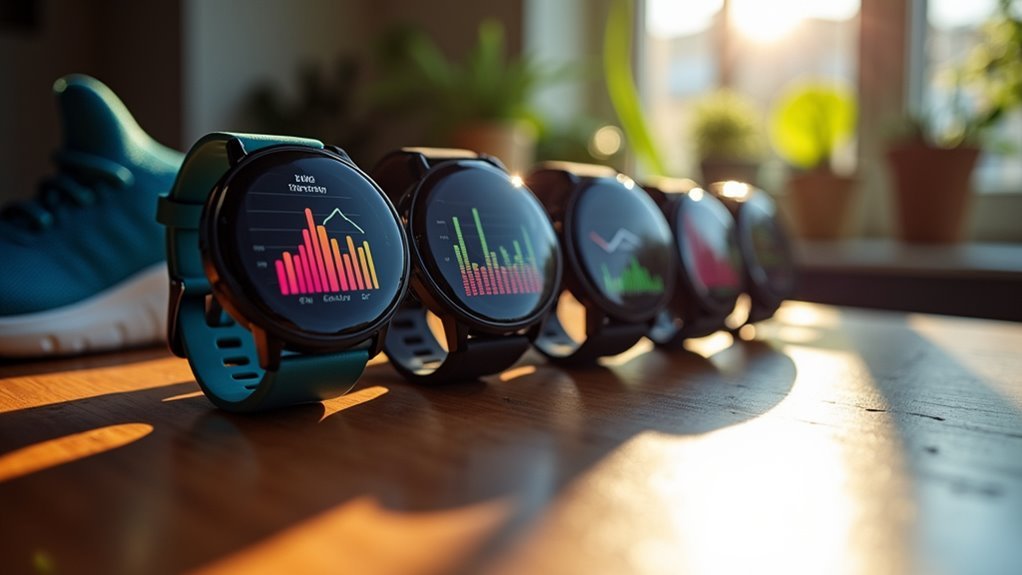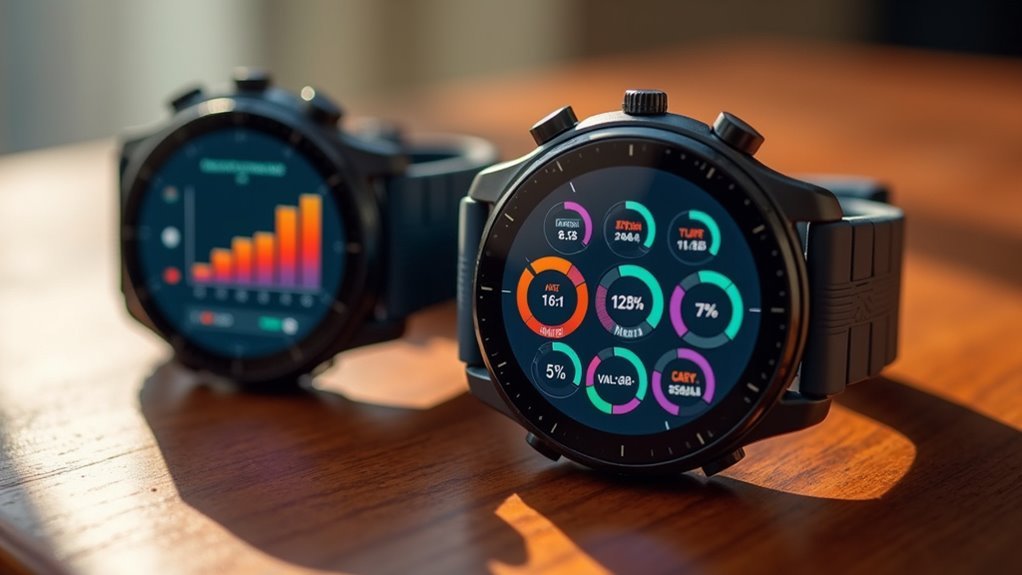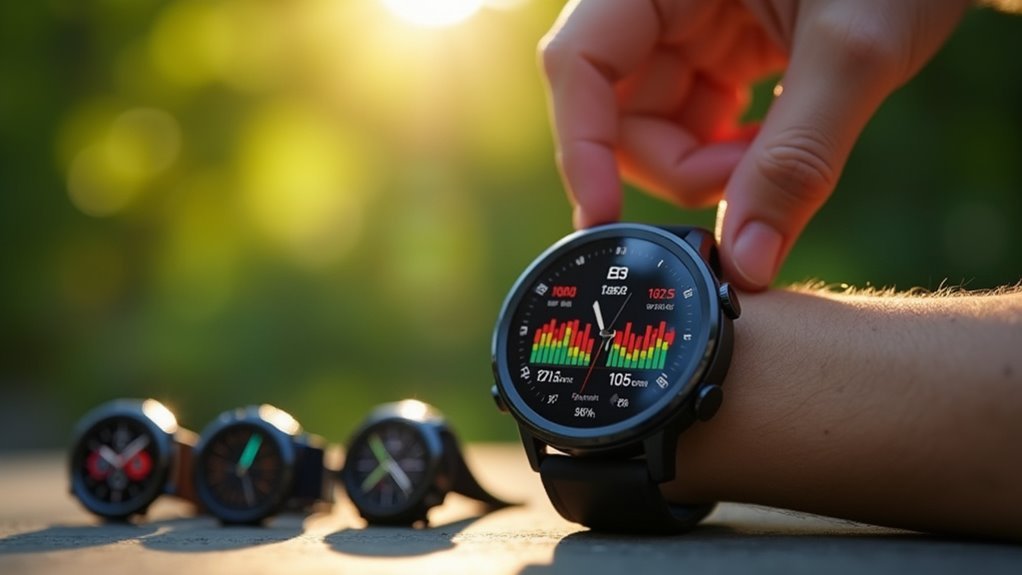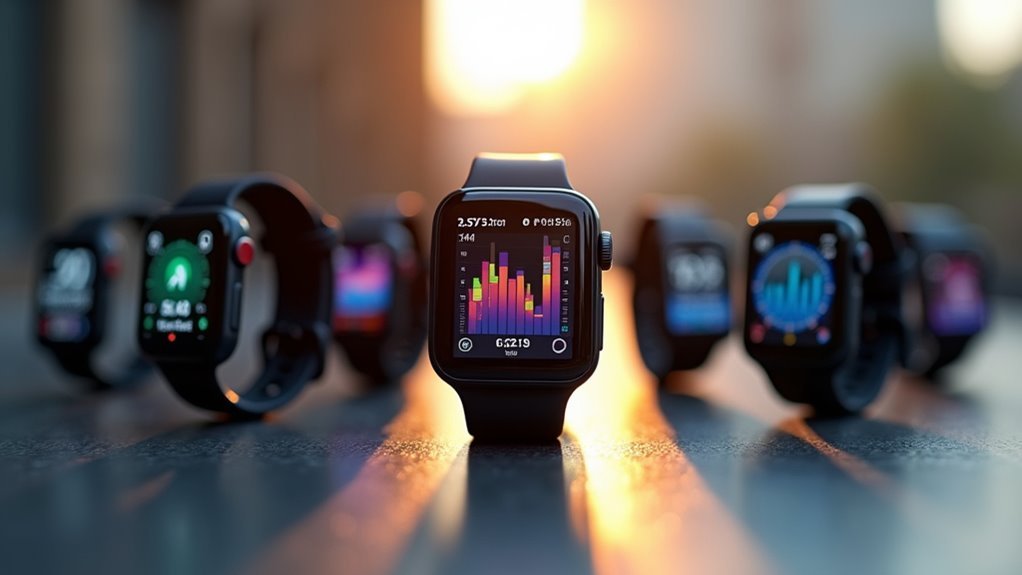You can share workout data across different sport watch ecosystems using third-party synchronization services like Health Sync and FitnessSyncer, which connect platforms like Garmin, Apple, Polar, and Samsung. These tools sync steps, calories, sleep patterns, and other metrics between devices. Some brands offer native export capabilities in formats like .fit, .gpx, and .tcx files. Setting up automated transfers requires granting API permissions and configuring privacy controls for secure data sharing across your fitness platforms and revealing extensive insights.
Understanding Cross-Platform Data Silos in Fitness Ecosystems

When you switch from your Garmin watch to an Apple Watch, you’ll quickly discover that your years of workout data don’t follow you.
Years of meticulously tracked workouts vanish the moment you dare to switch fitness brands.
This frustrating reality stems from cross-platform data silos—a deliberate design where fitness brands trap your workout information within their proprietary ecosystems.
Each major fitness company maintains its own closed data environment using unique software and APIs. Your Garmin data can’t easily transfer to Apple Health, just as your Fitbit metrics won’t sync with Google Fit without third-party workarounds.
These silos exist because brands want to keep you locked into their ecosystem, making it painful to switch competitors. Breaking down these barriers requires rigorous testing to identify and fix compatibility issues between different fitness platforms.
This fragmentation means you can’t see a complete picture of your fitness journey across different devices and platforms.
Third-Party Synchronization Services and Aggregation Tools
Several third-party synchronization services have emerged to break down these artificial barriers and unify your scattered fitness data. Health Sync and FitnessSyncer lead this space, connecting popular platforms like Strava, Garmin, Google Fit, and Samsung Health into extensive dashboards.
These tools automatically sync your steps, distance, calories burned, sleep patterns, and even blood pressure readings in the background. You’ll gain customizable visualizations and data export options for deeper analysis. They support multiple devices simultaneously, from Fitbit to Huawei wearables. Health Sync offers a lifetime license on iOS, making it an attractive option for long-term users.
However, you’ll face limitations. Garmin restricts data imports into Garmin Connect, while iOS functionality may be reduced compared to Android.
Network issues and background processing restrictions can affect sync reliability, and some apps block historical data access entirely.
Native Export and Import Capabilities Across Major Brands

While third-party services bridge gaps between platforms, many sport watch brands now offer direct export and import features that let you move data without intermediary tools.
Garmin leads with extensive exports in .fit, .gpx, .tcx, and .csv formats, plus import capabilities for Fitbit sleep data. Coros matches this flexibility with similar format support.
Polar exports .tcx files but won’t import them back, while Samsung offers .gpx exports requiring manual processing per workout.
You’ll find .fit files work best for detailed Garmin data, while .gpx handles GPS tracks across brands. Garmin watches allow complete data export for detailed analysis across all tracked metrics.
However, you’ll encounter limitations: Polar restricts imports, Samsung lacks direct import features, and manual transfers risk data loss.
These native capabilities reduce third-party dependence but still require careful format selection.
Setting Up Automated Data Transfer Between Devices
You’ll want to configure third-party sync services that can bridge different sport watch ecosystems and automatically transfer your workout data between devices.
Start by identifying compatible services like Strava, MyFitnessPal, or specialized fitness platforms that support API connections with your specific watch brands.
Set up these integrations by granting the necessary permissions and configuring the API settings to guarantee your workout data flows seamlessly across all your devices without manual intervention. Once configured, your synced workouts will contribute to closing activity rings and fitness goals across connected platforms, providing a comprehensive view of your fitness progress regardless of which device you use to track your activities.
Third-Party Sync Services
Third-party sync services bridge the gap between incompatible sport watch ecosystems by automatically transferring your workout data across platforms.
FitnessSyncer stands out with support for 100+ fitness websites and apps, offering free accounts with five sources or Pro accounts for unlimited connections.
Health Sync works well for Samsung Health and Google Fit integration, providing detailed daily metrics including steps.
You’ll find setup straightforward—most services use OAuth authentication requiring no coding skills.
Automated syncs can run on schedules or manual triggers, with data visualization dashboards showing your progress across platforms. These services leverage APIs to access data from different platforms and enable faster data transfer between healthcare applications.
However, consider limitations like free account restrictions, API constraints from native platforms, and data privacy concerns when granting broad health data access to third-party services.
API Integration Setup
For users with programming skills, API integration offers more control and customization than third-party sync services.
You’ll need to register your application with each wearable provider like Fitbit, Apple, or Garmin using OAuth authentication. Request detailed permissions for activity, health, body, and location data access during setup.
Each provider offers extensive documentation including API references, sample code, and SDK guides to streamline development.
You can configure webhooks or real-time endpoints for automated synchronization between devices. APIs expose endpoints for reading and writing fitness data in JSON or XML formats.
Most providers support both push and pull methods with scheduled syncs or event-based triggers.
You’ll handle ongoing API key management and security revisions while ensuring HIPAA and GDPR compliance for user data protection. Strava API provides access to 20 billion activities with comprehensive GPS tracking data for integration into your synchronization system.
Privacy Controls and User Authorization for Data Sharing

When you share workout data across different sport watch ecosystems, you’re exposing highly personal information that includes health metrics, location data, and activity patterns.
This sensitive data becomes valuable to advertisers and insurance companies who often purchase it from tracking companies.
You’ll need explicit consent before your data gets shared with third parties or healthcare providers. Most platforms require you to opt-in through transparent authorization processes.
However, you can take control by implementing granular privacy settings that let you specify exactly what information gets shared and with whom.
Review your privacy settings regularly and customize them to limit data sharing. Secure your accounts with strong passwords, enable two-factor authentication, and adjust third-party app permissions.
Monitor your accounts for suspicious activity and make certain your devices have the latest security patches installed. Be aware that changes in company ownership can significantly alter existing data privacy policies.
Real-Time Metrics and Dashboard Customization Options
Since modern sport watches generate continuous streams of health data, you’ll want real-time dashboards that consolidate metrics from multiple devices into a single, customizable interface.
These dashboards update every 30-60 seconds using WebSocket and MQTT protocols, ensuring you see current steps, calories, and heart rate across different ecosystems like Garmin, Apple, and Fitbit.
You can personalize your dashboard by rearranging widgets, setting custom goals, and choosing preferred visualization styles. The interface adapts to your activity patterns, highlighting sleep data at night and nutrition metrics in the morning.
Modern platforms now offer instant live rendering that processes image inputs from your fitness devices, allowing you to upload screenshots or photos of workout data for immediate visualization enhancement.
Key customization features include:
- Drag-and-drop widget arrangement for prioritizing relevant metrics
- Dynamic goal-setting modules for steps, calories, and workout targets
- Adaptive layouts based on time-of-day preferences
- Interactive charts with personalized color schemes and progress indicators
AI-Powered Analytics for Multi-Device Fitness Tracking
While traditional fitness tracking relies on individual device data, AI-powered analytics transforms your multi-device ecosystem into an intelligent fitness companion that learns from every heartbeat, step, and sleep cycle. Machine learning algorithms integrate data from all your devices, creating thorough activity profiles that reveal patterns invisible to single-device tracking.
| AI Feature | Functionality | Benefit |
|---|---|---|
| Data Integration | Combines multiple device inputs | Thorough activity view |
| Pattern Recognition | Analyzes cross-device trends | Identifies behavioral insights |
| Predictive Modeling | Forecasts performance outcomes | Optimizes training schedules |
| Real-Time Sync | Synchronizes data instantly | Consistent tracking accuracy |
You’ll receive personalized insights that adapt based on your progress, while AI standardizes data formats across different platforms, ensuring seamless sharing between your sport watches and fitness trackers. Advanced sensors can automatically detect and track fitness activities without manual intervention, making the transition between different devices completely seamless through auto track functionality.
Overcoming Ecosystem Lock-In With Universal Protocols
Despite the convenience of manufacturer-specific fitness ecosystems, proprietary data formats create digital walls that trap your workout information within single-brand silos.
Universal protocols break these barriers by establishing common communication standards that let your data flow freely between different sport watch brands and platforms.
Open APIs and standardized formats like JSON, XML, and HL7 FHIR enable seamless data exchange without corruption or loss. These standards provide a common language that ensures appropriate and secure sharing of fitness information across different platforms and devices.
You’ll gain device flexibility and avoid vendor restrictions that limit your choices.
Key benefits of universal protocols include:
- Data portability – Move workout history between different brands effortlessly
- Third-party integration – Connect with specialized analytics apps and health platforms
- Future-proofing – Maintain access to your data as technology evolves
- Enhanced innovation – Foster competitive development across ecosystems
Frequently Asked Questions
Can I Sync Workout Data if My Devices Use Different Measurement Units?
You can sync workout data between devices using different measurement units. Many apps automatically convert units, while others require manual adjustment. You’ll need to guarantee consistency across platforms for accurate tracking and analysis.
What Happens to My Data if a Third-Party Sync Service Shuts Down?
If a third-party sync service shuts down, you’ll lose access to that syncing functionality. Your historical data might become fragmented across devices, requiring you to find alternative solutions or manually export data beforehand.
Do Fitness Apps Drain More Battery When Constantly Syncing Across Multiple Devices?
Yes, fitness apps drain more battery when you’re constantly syncing across multiple devices. You’ll notice increased consumption because your devices continuously communicate, transfer data, and maintain Bluetooth connections throughout the day.
Can I Selectively Share Only Certain Types of Workouts Between Different Ecosystems?
You can selectively share specific workout types between ecosystems. Apple Health, Fitbit, and Garmin offer granular controls letting you choose which activities sync while blocking others you’d prefer keeping private.
Will Syncing Data Affect My Device Warranties or Violate Terms of Service?
You shouldn’t worry about basic data syncing affecting your warranties, but you must review each device’s terms of service since unauthorized modifications or prohibited data sharing could potentially void your warranty coverage.
In Summary
You’re no longer trapped by brand loyalty when tracking your fitness journey. By leveraging third-party sync services, automated transfers, and universal protocols, you’ll break free from ecosystem silos that limit your data’s potential. You’ll gain extensive insights across all your devices while maintaining privacy control. Don’t let proprietary barriers dictate your workout tracking—you’ve got the tools to create a unified, AI-enhanced fitness dashboard that works for you.





Leave a Reply